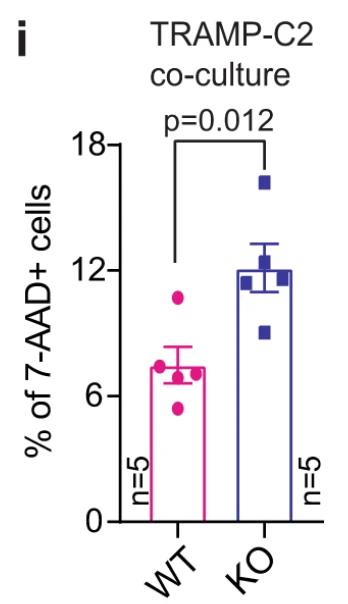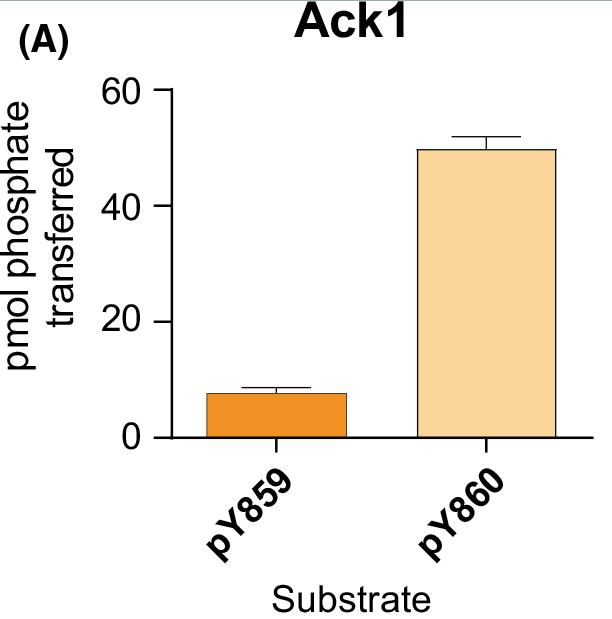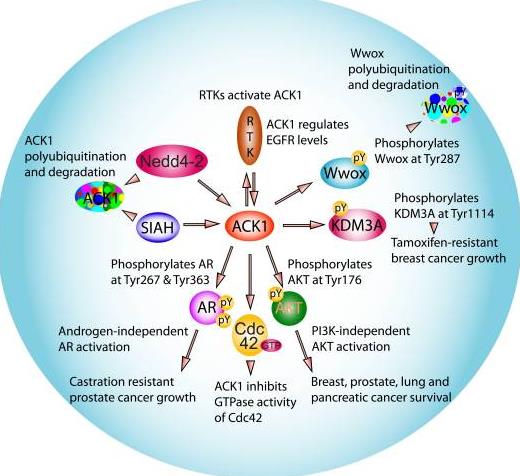Recombinant Human ACK1 protein(Gly110-Trp476), GST-tagged
| Cat.No. : | ACK1-782H |
| Product Overview : | Recombinant Human ACK1(NP_005772.3)(Gly 110-Trp 476) was expressed in Insect Cells with the GST tag at the N-terminus. |
| Availability | April 20, 2025 |
| Unit | |
| Price | |
| Qty |
- Specification
- Gene Information
- Related Products
- Case Study
- Application
- Download
| Species : | Human |
| Source : | Insect Cells |
| Tag : | GST |
| Protein Length : | 110-476 a.a. |
| Form : | Supplied as sterile 20mM Tris, 500mM NaCl, pH 7.4, 10% glycerol, 0.5mM EDTA, 0.5mM PMSF, 0.5mM TCEP. |
| Bio-activity : | The specific activity was determined to be >4 nmol/min/mg using synthetic Abl peptide (EAIYAAPFAKKK) as substrate. |
| Molecular Mass : | The recombinant human ACK1/GST chimera consists of 592 amino acids and predicts a molecular mass of 68 kDa. It migrates as an approximately 62 kDa band in SDS-PAGE under reducing conditions. |
| Endotoxin : | < 1.0 EU per μg of the protein as determined by the LAL method |
| Purity : | > 85 % as determined by SDS-PAGE |
| Storage : | Samples are stable for up to twelve months from date of receipt at -20°C to -80°C. Store it under sterile conditions at -20°C to -80°C. It is recommended that the protein be aliquoted for optimal storage. Avoid repeated freeze-thaw cycles. |
| Reconstitution : | It is recommended that sterile water be added to the vial to prepare a stock solution of 0.2 ug/ul. Centrifuge the vial at 4°C before opening to recover the entire contents. |
| ◆ Recombinant Proteins | ||
| TNK233268H | Recombinant Human ACK1 (107-395) Protein, His-tagged | +Inquiry |
| ACK1-782H | Recombinant Human ACK1 protein(Gly110-Trp476), GST-tagged | +Inquiry |
Case 1: Sridaran D, et al. Nat Commun. 2022
Solid tumors tend to be tough nuts to crack when it comes to immune checkpoint blockade (ICB) therapies, mainly because T cells, which are critical in attacking these tumors, often struggle to function properly or even get to the tumor site. That's where ACK1, a tyrosine kinase, comes into play. It phosphorylates CSK at a sp ecific spot, which boosts CSK's role in holding back T-cell activation. Mice without the ACK1 gene show less phosphorylation at this site and have more active T cells, which helps slow down the growth of tumors that usually resist ICB treatments. In humans, particularly in those with castration-resistant prostate cancer, ICB treatments reactivate this ACK1 pathway, tying it to ICB resistance. However, there's hope in the form of a small-molecule inhibitor called ®-9b, which has shown promise in overcoming this resistance, highlighting ACK1's crucial part in the problem.

Fig1. HEK293T cells were co-transfected with FLAG-tagged CSK and HA-tagged ACK1 or cACK1.

Fig2. WT and Ack1 KO mice splenocytes were co-cultured with TRAMP-C2 cells.
Case 2: Kan Y, et al. FEBS Lett. 2022
Ack1 is a type of tyrosine kinase that's a bit of a cancer player, similar to a tumor suppressor called Mig6, which blocks the epidermal growth factor receptor (EGFR). In Ack1, the part that binds similar to Mig6 is called the Mig6 homology region (MHR). Researchers took a look to see if the way the MHR and the kinase domain (KD) of Ack1 interact with each other could be influenced by the addition of phosphate groups, a process called phosphorylation. Turns out, there are two specific spots, Y859 and Y860, in this MHR area that get phosphorylated, and when Src, a kinase, adds phosphate to these spots, Ack1 gets more active. When put Src and Ack1 together in cells, Ack1 activity shot up, but changing Y859/Y860 stopped this boost. This whole thing appears to crank up Ack1's enzyme action, especially in cancers like those in the brain, breast, colon, and prostate, where Ack1 is often ramped up or mutated, helping the disease progress.

Fig1. FLAG-tagged Ack1 was transfected into HEK293T cells alone, or together with a constitutively active version of Src.

Fig2. Phosphorylation of the synthetic phospho-peptides by Ack1 KD-SH3 was measured using the phosphocellulose-binding assay.
Human ACK1, also known as activated Cdc42-associated kinase 1 or TNK2, is a pretty key player in a bunch of cellular functions. It's mainly known for managing clathrin-mediated endocytosis and has been linked to several human illnesses like neuropathic pain, viral infections, Alzheimer's, and Parkinson's. This protein is highly active in the central nervous system and teams up with various receptor tyrosine kinases, like EGFR, AXL, and ALK, which are big in controlling how cells grow, survive, and move. Lately, there's been a buzz about how targeting ACK1 might offer new ways to treat cancers, especially since it seems to play a role in cancer progression and resistance to usual treatments. Plus, it's been noted for influencing immune pathways in non-small cell lung cancer, showing it has some immune-related roles in cancer too. ACK1's structure, which includes several domains like a SAM, kinase domain, and SH3 domain, helps it interact with many different proteins and adapt to various cellular environments, making it quite versatile. Researchers are exploring ACK1 inhibitors as potential treatments, hoping to tackle diseases linked to its abnormal activity.
Recombinant human ACK1 protein is widely used in scientific research and industry. In scientific research, this protein is often used to study cell signaling and cancer mechanisms, providing scientists with important information about how cells communicate and how cancer cells develop. In industry, especially in the pharmaceutical and biotechnology sectors, ACK1 is used to develop novel anticancer therapies and other related drugs. The aim of studying and applying this protein is to advance innovation in health and medicine by improving the understanding of cell signaling and cancer.

Fig1. ACK1 kinase network where it functions as a conveyer of signals from a diverse group of activated receptor tyrosine kinases. (K Mahajan, 2015)
Not For Human Consumption!
Inquiry
- Reviews
- Q&As
Ask a Question for All ACK1 Products
Required fields are marked with *
My Review for All ACK1 Products
Required fields are marked with *
Inquiry Basket


